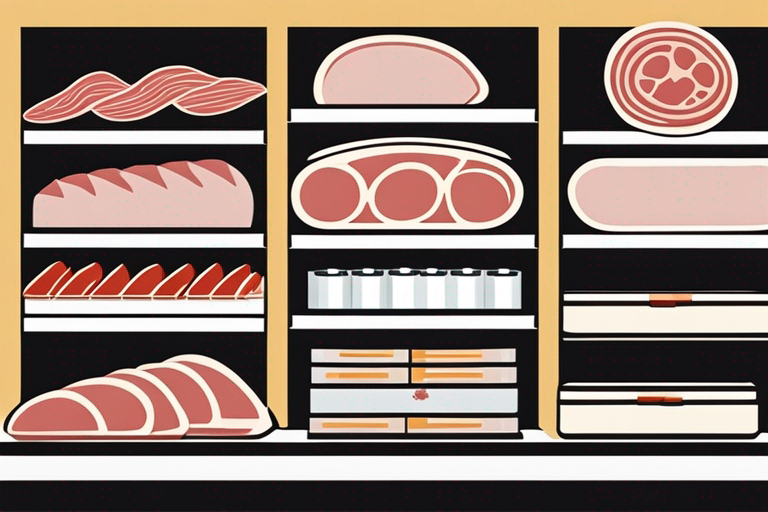
The Essential Guide to Cold Cuts Expiration: How to Keep Your Deli Meats Safe
Get Your Free Food Safety Cheat Sheet
30 most common foods with instant answers. Print it and stick it on your fridge—completely free!
The Essential Guide to Cold Cuts Expiration: How to Keep Your Deli Meats Safe
In today's fast-paced world, cold cuts are a convenient and popular choice for sandwiches, salads, and party platters. However, like all perishable foods, cold cuts have a limited shelf life and can pose health risks if not stored and handled correctly. In this guide, we will explore everything you need to know about cold cuts expiration, including safety tips, storage guidelines, and how to tell if your deli meats have gone bad.
Understanding Cold Cuts Expiration Dates
Cold cuts, also known as deli meats or lunch meats, are precooked or cured meats that are sliced and typically served cold. These meats include popular varieties such as ham, turkey, roast beef, salami, and bologna. While cold cuts can be a tasty addition to meals, it's essential to pay attention to their expiration dates to avoid foodborne illnesses.
How to Interpret Cold Cuts Expiration Dates
When purchasing cold cuts from the deli or grocery store, you may notice various date labels on the packaging. Understanding these dates can help you determine the freshness and safety of the product:
-
Sell-By Date: This date indicates how long the store should display the product for sale. It is not an expiration date but rather a guideline for retailers.
-
Use-By Date: This date is the manufacturer's recommendation for when the product should be consumed for the best quality. Consuming the product after this date may affect taste and texture but does not necessarily mean it is unsafe to eat.
-
Expiration Date: This date signifies the last day the product should be consumed for optimal quality. Consuming the product after this date may pose health risks.
Factors Affecting Cold Cuts Shelf Life
Several factors can influence the shelf life of cold cuts, including:
-
Temperature: Cold cuts should be stored at a consistent temperature of 40°F (4°C) or below to slow down bacterial growth.
-
Packaging: Properly sealed packaging helps maintain the freshness of cold cuts and prevents cross-contamination.
-
Storage Conditions: Store cold cuts in the refrigerator, away from raw meats and other perishable items.
-
Handling: Always use clean utensils and wash your hands before handling cold cuts to prevent contamination.
Real-Life Scenarios: When Cold Cuts Go Wrong
To illustrate the importance of these guidelines, let’s look at a couple of real-life examples.
Scenario 1: The Family Picnic
Imagine a family planning a lovely picnic. They pack sandwiches with turkey and cheese, but they forget to keep the cooler well-iced. After a few hours in the sun, the turkey sits at unsafe temperatures. Upon return, someone notices a slightly off smell. Unfortunately, they ignore it, thinking the sandwiches are still fine. Later, several family members experience stomach cramps. This serves as a crucial reminder that letting cold cuts sit out, even for a short time, can lead to foodborne illness.
Scenario 2: The Quick Lunch
Another scenario involves a busy professional grabbing a quick lunch at work. They check the expiration date on pre-packaged ham and see it’s still valid. However, they fail to notice that the package has been opened for over a week and is now in the back of the fridge. When they take a bite, they notice a slimy texture and off-smell, but it’s too late. It’s essential to consistently check not only the expiration date but also the condition of the meat, especially for leftovers.
Scenario 3: The Super Bowl Party Planning
Picture a group of friends prepping for a Super Bowl party. They buy a variety of deli meats to create a grand sandwich platter. The meats are kept in the refrigerator during the party, but after a few hours of people serving themselves, they notice the meat is sitting out for over two hours. Forgetting to adhere to the two-hour rule, they unknowingly put themselves at risk for food poisoning. The next day, several partygoers report feeling unwell, reminding everyone of the critical importance of monitoring food safety during gatherings.
Signs of Spoiled Cold Cuts
It's crucial to be able to identify when cold cuts have gone bad to avoid foodborne illnesses. Here are some signs that your deli meats may have spoiled:
-
Off Odor: If the cold cuts have a sour, ammonia-like, or off-putting smell, they may be spoiled.
-
Slimy Texture: Spoiled cold cuts may feel slimy or sticky to the touch.
-
Discoloration: Look for any unusual discoloration, such as dark spots or a greenish tint, on the meat.
-
Mold Growth: Visible mold growth on cold cuts is a clear indicator that they should be discarded.
Proper Storage Tips for Cold Cuts
To maximize the shelf life of your cold cuts and ensure food safety, follow these storage tips:
-
Refrigerate Promptly: Store cold cuts in the refrigerator within two hours of purchase or preparation.
-
Use Air-Tight Containers: Transfer deli meats to air-tight containers or resealable bags to prevent exposure to air and odors.
-
Separate Raw and Cooked Foods: Keep raw meats separate from cold cuts to prevent cross-contamination.
-
Rotate Stock: Use older cold cuts before newer ones to ensure freshness.
Storage Methods Explained
Many people don’t realize that the way they store cold cuts can significantly affect their shelf life. Here are a few practical tips to enhance your storage:
-
Vacuum Sealing: If you buy cold cuts in bulk, consider vacuum sealing portions you won’t use immediately. This method removes air and significantly extends the freshness of the meat.
-
Freezing: While cold cuts can be stored in the fridge for several days, they can also be frozen for longer storage. Wrap them tightly in plastic wrap and then place them in a freezer-safe bag. They can be stored in the freezer for up to two months. Just remember to thaw them properly in the refrigerator before use.
-
Labeling: Always label your cold cuts with the date of purchase or opening. This simple step can help you keep track of freshness and avoid any nasty surprises when you reach for a sandwich at lunch.
Common Mistakes People Make
Despite good intentions, many people make common errors when it comes to handling and storing cold cuts:
-
Ignoring Storage Temperature: Maintaining the right temperature is crucial. Some people might think that leaving cold cuts out for “just a little while” is fine, but the risk of bacterial growth increases significantly when temperatures exceed 40°F (4°C).
-
Cross-Contamination: Using the same cutting board and knife for cold cuts and raw meats without proper cleaning can lead to cross-contamination, putting you at risk for foodborne illness.
-
Keeping Cold Cuts Too Long: Just because cold cuts are labeled with a future expiration date doesn't mean they're safe to consume indefinitely. The moment you open the package, the clock starts ticking on freshness.
-
Not Using Smell as a Guide: Many people overlook the power of their sense of smell. If you catch a whiff of something off when opening the package, it’s best to err on the side of caution and discard it.
-
Not Being Aware of Potential Allergens: Deli meats often contain preservatives and additives that can cause allergic reactions in some individuals. Always read labels carefully to avoid unwanted surprises.
Expert Insights: Recommendations from Food Safety Professionals
Food safety experts recommend being proactive about your cold cuts. Here are some professional insights:
-
Check for Signs of Spoilage Regularly: Instead of waiting until you’re ready to eat, make it a habit to check your cold cuts every few days for any signs of spoilage.
-
Follow FIFO (First In, First Out): This practice is crucial in food storage. Use older items first before newer ones to minimize waste and ensure freshness.
-
Consult Local Guidelines: Food safety guidelines can vary by region. It’s beneficial to check with your local health department for specific recommendations on cold cut storage and handling.
-
Educate Yourself on Foodborne Pathogens: Familiarize yourself with common bacteria found in deli meats, such as Listeria monocytogenes, which can thrive even at refrigeration temperatures. Knowledge is power when it comes to food safety.
-
Utilize Meat Thermometers: While cold cuts are typically precooked, ensuring they reach a safe internal temperature before serving, particularly when reheating, can further reduce any risk of bacteria.
Conclusion
In conclusion, understanding cold cuts expiration dates and proper storage practices is essential for maintaining food safety and quality. By following the guidelines outlined in this guide, you can enjoy your favorite deli meats while reducing the risk of foodborne illnesses. Remember to always check for signs of spoilage and discard any cold cuts that show signs of being unsafe to consume.
Stay informed, stay safe, and enjoy your cold cuts responsibly. With these tips in mind, you can indulge in delicious sandwiches without the worry of food poisoning. Whether you’re preparing a quick lunch for yourself or a festive spread for a family gathering, a little knowledge about cold cuts can go a long way in ensuring a safe and enjoyable dining experience.
By incorporating these expert insights and real-life scenarios into your routine, you’ll not only extend the life of your deli meats but will also cultivate a deeper understanding of food safety practices that can be applied to all areas of your kitchen. So next time you reach for that package of cold cuts, you'll not only enjoy your meal but do so with the confidence that you’re keeping yourself and your loved ones safe.

Authoritative Food Safety References
These agencies and university labs inform every tip and health precaution we publish.
USDA FoodKeeper – Cold Storage Guidelines
Official refrigerator, freezer, and pantry timelines maintained by the U.S. Department of Agriculture.
Visit USDA FoodKeeperFDA Produce Safety Rule & Grower Guidance
Field-to-fridge handling practices that prevent contamination of fruits, vegetables, and leafy greens.
Visit FDA Produce SafetyCDC Foodborne Illness Prevention Hub
Surveillance-backed guidance on pathogens, symptoms, and steps to reduce foodborne illness risk.
Visit CDC Food SafetyUC Davis Postharvest Technology Center
University research detailing optimal storage atmospheres for produce after harvest.
Visit UC Davis PostharvestPenn State Extension – Home Food Preservation & Safety
Peer-reviewed extension bulletins on safe canning, chilling, and reheating practices.
Visit Penn State ExtensionHow long can cold cuts last in the refrigerator?
Can I freeze deli meats to extend their shelf life?
What are the signs that cold cuts have gone bad?
Can I eat cold cuts past their expiration date?
How should I store deli meats to keep them fresh?
Get Your Free Food Safety Cheat Sheet
30 most common foods with instant answers. Print it and stick it on your fridge—completely free! Want more? Upgrade to the complete guide with 70+ foods.
Scan your food directly and get instant safety info using our AI-powered camera feature.